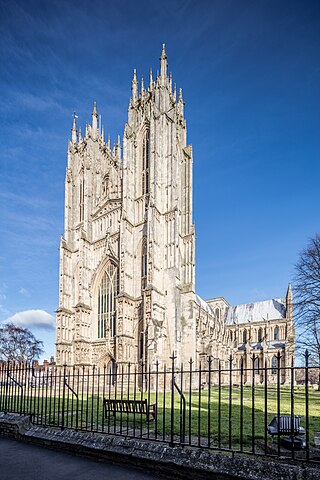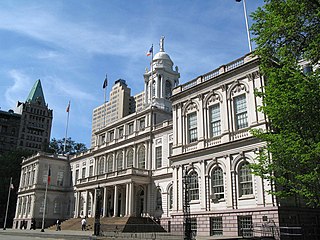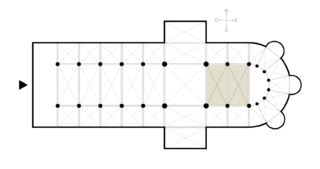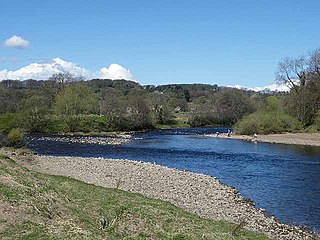
A seat is a place to sit. The term may encompass additional features, such as back, armrest, head restraint but also headquarters in a wider sense.

A cathedral is a church that contains the cathedra of a bishop, thus serving as the central church of a diocese, conference, or episcopate. Churches with the function of "cathedral" are usually specific to those Christian denominations with an episcopal hierarchy, such as the Catholic, Eastern Orthodox, Anglican, and some Lutheran churches. Church buildings embodying the functions of a cathedral first appeared in Italy, Gaul, Spain, and North Africa in the 4th century, but cathedrals did not become universal within the Western Catholic Church until the 12th century, by which time they had developed architectural forms, institutional structures, and legal identities distinct from parish churches, monastic churches, and episcopal residences. The cathedral is more important in the hierarchy than the church because it is from the cathedral that the bishop governs the area under his or her administrative authority.

A synagogue, sometimes referred to by the Yiddish term shul and often used interchangeably with the word temple, is a Jewish house of worship. Synagogues have a place for prayer, where Jews attend religious services or special ceremonies, have rooms for study, social hall(s), administrative and charitable offices, classrooms for religious school and Hebrew school, sometimes Jewish preschools, and often have many places to sit and congregate; display commemorative, historic, or modern artwork throughout; and sometimes have items of some Jewish historical significance or history about the Synagogue itself on display.

An altar is a table or platform for the presentation of religious offerings, for sacrifices, or for other ritualistic purposes. Altars are found at shrines, temples, churches, and other places of worship. They are used particularly in paganism, Christianity, Buddhism, Hinduism, Judaism, modern paganism, and in certain Islamic communities around Caucasia and Asia Minor. Many historical-medieval faiths also made use of them, including the Roman, Greek, and Norse religions.

A sanctuary, in its original meaning, is a sacred place, such as a shrine. By the use of such places as a haven, by extension the term has come to be used for any place of safety. This secondary use can be categorized into human sanctuary, a safe place for people, such as a political sanctuary; and non-human sanctuary, such as an animal or plant sanctuary.

Beverley is a market and minster town and a civil parish in the East Riding of Yorkshire, England, of which it is the county town. The town centre is located 27 miles (43 km) south-east of York's centre and 15 miles (24 km) north-west of City of Hull.

Beverley Minster, otherwise known as the Parish Church of Saint John and Saint Martin, in Beverley, East Riding of Yorkshire, is a parish church in the Church of England. It is one of the largest parish churches in the UK, larger than one-third of all English cathedrals and regarded as a Gothic masterpiece by many.
Frith is an Old English word meaning "peace; protection; safety, security, freedom, refuge".

A throne is the seat of state of a potentate or dignitary, especially the seat occupied by a sovereign on state occasions; or the seat occupied by a pope or bishop on ceremonial occasions. "Throne" in an abstract sense can also refer to the monarchy or the Crown itself, an instance of metonymy, and is also used in many expressions such as "the power behind the throne".

A chair is a type of seat, typically designed for one person and consisting of one or more legs, a flat or slightly angled seat and a back-rest. They may be made of wood, metal, or synthetic materials, and may be padded or upholstered in various colors and fabrics.

In local government, a city hall, town hall, civic centre, guildhall, or a municipal building, is the chief administrative building of a city, town, or other municipality. It usually houses the city or town council, its associated departments, and their employees. It also usually functions as the base of the mayor of a city, town, borough, county or shire, and of the executive arm of the municipality.
A safe house is, in a generic sense, a secret place or sanctuary to hide people from the law; hostile actors or actions; from retribution; and from threats or perceived danger. It may also be a metaphor.

Ducking stools or cucking stools were chairs formerly used for punishment of disorderly women, scolds, and dishonest tradesmen in England, Scotland, and elsewhere. The cucking-stool was a form of wymen pine, or "women's punishment", as referred to in Langland's Piers Plowman (1378). They were instruments of public humiliation and censure both primarily for the offense of scolding or backbiting and less often for sexual offences like bearing an illegitimate child or prostitution.

An ottoman is a piece of furniture. Generally ottomans have neither backs nor arms. They may be an upholstered low couch or a smaller cushioned seat used as a table, stool or footstool. The seat may have hinges and form a lid for the inside hollow, which can be used for storage of linen, magazines or other items, making it a form of storage furniture. The smaller version is usually placed near to an armchair or sofa as part of living room decor or may be used as a fireside seat.

A table is an item of furniture with a raised flat top and is supported most commonly by 1 or 4 legs, used as a surface for working at, eating from or on which to place things. Some common types of table are the dining room table, which is used for seated persons to eat meals; the coffee table, which is a low table used in living rooms to display items or serve refreshments; and the bedside table, which is commonly used to place an alarm clock and a lamp. There are also a range of specialized types of tables, such as drafting tables, used for doing architectural drawings, and sewing tables.

A choir, also sometimes called quire, is the area of a church or cathedral that provides seating for the clergy and church choir. It is in the western part of the chancel, between the nave and the sanctuary, which houses the altar and Church tabernacle. In larger medieval churches it contained choir-stalls, seating aligned with the side of the church, so at right-angles to the seating for the congregation in the nave. Smaller medieval churches may not have a choir in the architectural sense at all, and they are often lacking in churches built by all denominations after the Protestant Reformation, though the Gothic Revival revived them as a distinct feature.

Akropong is a town in South Ghana and is the capital of the Akuapim North District, a district in the Eastern Region of South Ghana. This town is known for producing snails and palm oil. Akropong has a 2013 settlement population of 13,785 people.

Warden is a village in Northumberland, England about 2 miles (3 km) west of Hexham.

Chapel-en-le-Frith is a town and civil parish in the Borough of High Peak in Derbyshire, England.

Hiring fairs, also called statute or mop fairs, were regular events in pre-modern Great Britain and Ireland where labourers were hired for fixed terms. They date from the time of Edward III, and his attempt to regulate the labour market by the Statute of Labourers in 1351 at a time of a serious national shortage of labour after the Black Death. Subsequent legislation, in particular the Statute of Apprentices of 1563, legislated for a particular day when the high constables of the shire would proclaim the stipulated rates of pay and conditions of employment for the following year. Because so many people gathered at a fair, it quickly turned into the major place for matching workers and employers. Hiring fairs continued well into the 20th century, up to the Second World War in some places but their function as employment exchanges was diminished by the Corn Production Act 1917. This legislation guaranteed minimum prices for wheat and oats, specified a minimum wage for agricultural workers and established the Agricultural Wages Board, to ensure stability for farmers and a share of this stability for agricultural workers.


















